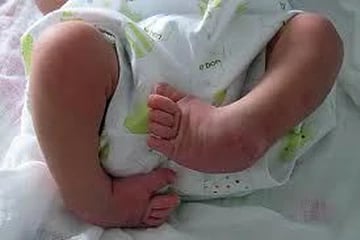In light of the K-Taping for Pediatrics course that will be offered 2018, Andrea Mendoza, physiotherapist and owner of the Scoliclinic, posted this 2014 blog about the effectiveness of K-Tape while on a volunteer mission in India.
Another supporter of Dollars For Development was OrthoCanada. At the ScoliClinic, I often use a fabulous brand of athletic tape called K-Tape, which OrthoCanada supplies and SportMed Retail Group in Vancouver carries. This tape is made of woven cotton that has properties allowing it to stretch, move, breathe, and resist water – this works great on active kids as it’s so resilient! There are many brands of this stretch tape available, but I’ve personally found that K-Tape has been the most durable and resistant to tearing (especially when placed on max stretch).
At a home visit off the Samuha Samarthy campus, Hilary and I assessed a 4-month-old infant with spina bifida – a condition where the neural tube and spinal canal don’t form properly due to lack of folic acid and as a result the spinal cord protrudes from the back of the baby; functionally it presents as a spinal cord injury and will affect the child throughout his life. This baby had a surgery to close the tube when he was one day old, but still suffers several issues. Often, spina bifida is associated with hydrocephalus (enlarged head due to excess brain fluid) and/or club feet (congenital deformity of the foot bones). Luckily, this baby only had moderate clubbing of the feet – in the rest position, the toes all point towards each other but it was correctable, i.e. there wasn’t a contracture of the tissues of joints… yet.
We felt that hard plastic splints/plaster casting weren’t warranted for this baby yet, but he needed some sort of support to prevent contractures from forming until he started weight-bearing and standing. OrthoCanada had generously donated two mega rolls of K-Tape (each roll equal to five small rolls), so I wanted to give that a try.
Here comes the physio jargon: I used a standard eversion support taping technique, applying tension from medial to lateral, but anchored my first strip diagonally on the plantar aspect of the hallux to include support for the metatarsals (as he had some metatarsus adductus as well). The result: a much more neutrally-positioned foot which would prevent medial ankle capsule tightness from developing! Note, I forgot to get a ‘before’ photo, but here’s a close comparison to what this baby’s feet did look like:

We applied the tape and here’s what his resting position was like after:



We taught the family how to apply the tape as well, gave thorough instructions to check the skin and use oil to remove it painlessly. Because of our generous supply of tape, we were also able to give the family a few weeks worth to use at home. Thanks OrthoCanada and K-Tape – this really made a difference in this baby’s life.

Andrea Mendoza, physiotherapist and owner of the Scoliclinic
K-Taping for Pediatrics course information

If you are NOT a Healthcare Professional but have a question? Click here >
Free Shipping
On orders over $250
Learn More>
Get Expert Advice
For Healthcare Professionals only
1-800-561-0310
Contact us >
Technical Support
Does your equipment need
maintenance or calibration?
Contact us >
Finance Your Success
Leasing equipment is simple?
Learn more >
Customer Service Hours: Monday to Friday from 8:00 AM to 5:00 PM EST
Fax: 1-800-561-0349
Mailing Address: 170 Bombardier, Unit 1, Gatineau, QC J8R 0G5